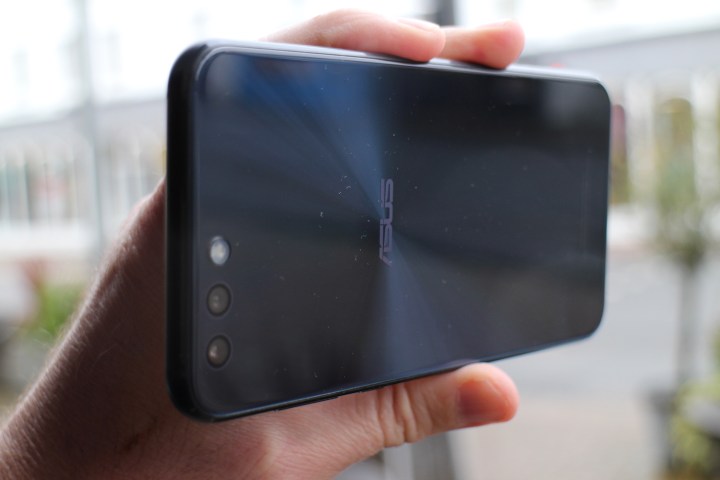
You decided the Asus Zenfone 4 is the phone for you, a decision likely swayed by the dual-lens camera that takes wide-angle shots, instead of yet another implementation of the blurred background, bokeh effect. Now the phone is in your hand, how about a quick overview of how to use the top five features in the Zenfone 4’s camera app?
Wide-angle mode

Open the main camera app and you’re greeted with a lot of buttons and information to take in. Don’t worry, you will soon be familiar with it. The first, and probably the most important, is the way to activate wide-angle mode. In the lower half of the screen, just above the shutter release, are two icons that look like mountains. The left icon is for standard view and the icon on the right denotes wide-angle mode. Tap either one to swap between them.

You will know which mode you’re in because the icon changes to a green color, and main camera or wide-angled camera flashes across the screen, plus if you take a look in the top right (in landscape orientation) the software will remind you too.
Portrait mode
Just because the two camera lenses are for wide-angle shots, doesn’t mean Asus has ignored your desire for bokeh shots. The ZenFone 4 has a Portrait mode, but it’s a little temperamental. It’s activated from the main camera viewfinder page.
Look along the top row of icons, and tap on the button that looks like two people. It should be crossed out when you first open the app. A green notification will appear saying you’re in Portrait mode. Portrait mode operates in both the front and rear cameras, but depends on good lighting conditions and being fairly close to the camera lens.
- 1. Portrait mode off
- 2. Portrait mode activated
If you’re expecting to take bokeh shots of flowers, cats, or any other object you may be disappointed. The ZenFone 4 isn’t very good at picking these items out in its Portrait pictures, and you’re left with a very normal shot. Point the camera at a person and it gets better but in our tests, you needed to be up close to get a strong effect.
Press the button again to cancel Portrait mode.
Be a Selfie Master
The Asus ZenFone 4 has a selfie mode in the main camera app, and a separate app called Selfie Master. We found using the main camera app was perfectly acceptable for selfies, due to its extensive range of beautification settings. Here is how to get started.
- Tap the button to the right of the shutter release (in portrait orientation) to swap to the front camera.
- Activate Beauty Mode with the button on the far left of the shutter release.
- To use Portrait mode, tap the button that looks like two people along the top row of icons.
- If you want to play around with the beauty settings, look for the Settings icon in the bottom right of the viewfinder. It’s sometimes a little hard to see as it can blend into the background. Tap it and you’ll see a row of settings appear along the bottom of the viewfinder.
- Tap each one to adjust the properties. From left to right they are: Skin Tone, Soften Skin, Brighten Skin, Enhance Eyes, and Thin Cheeks. Each one has a left-to-right slider to increase or decrease the effect.
- If you don’t want to mess around with the individual settings, just tap Auto to let the phone sort everything out for you.
- Next to the Settings button, there is an icon that looks like a lightbulb. Tap this to alter the warmth of the lighting around you — it’s handy if you’re under fluorescent light, for example.
Photo editing
Asus has built a comprehensive photo editing suite into its Gallery app. From the main home screen on your phone, tap Gallery and find the picture you’d like to edit. Tap it and then look on the bottom right (in portrait orientation) for an icon that looks like a picture with a pen. Tap it to open the edit mode.
- All the important settings run along the bottom of the screen. By default, when you open the edit mode you’re presented with various filters. Tap each to apply them to the image, and scroll through the list to see different effects.
- Look at the bottom of the screen and tap the next icon to the right, which lets you add different frames to your photo.
- The next icon has tools for cropping, rotating, straightening, or mirroring the photo.
- Finally, the icon furthest on the right is for altering each individual aspect of the photo, including sharpness, highlights, shadows, exposure, and more. Tap each setting and use the slider to adjust the properties.
- When you’re happy with the image, save it using the button shaped like a computer disk in the top left of the screen.
- On the opposite side of this icon are two handy icons where you can take away any effects you added, in case you change your mind.
Sticky icons
- 1. Sticky icon in bottom left
- 2. Camera modes
In the main camera app, there is an icon for Pro mode in the top left of the screen (in landscape orientation), but this can be changed to access a different mode if you use it more often. Swipe down on the main screen to enter mode selection. You will find the Zenfone 4’s different camera features, including panorama, Pro mode, and various video modes. Pro mode will likely have a pin icon on it, denoting it’s pinned to the main camera screen.
If you tap and hold down any other icon, the pin will jump over to it and that mode will be accessible directly from the main camera screen.
That is it! Enjoy using your Asus Zenfone 4 and its cool wide-angle camera.
Editors' Recommendations
- The best golf apps for iPhone and Android: 8 best ones in 2023
- The best rideshare apps in 2023: top 11 apps to check out
- The best Android VPN in 2022
- The best gardening apps for 2022
- Samsung Galaxy Tab S8 Plus vs. iPad Air 4












